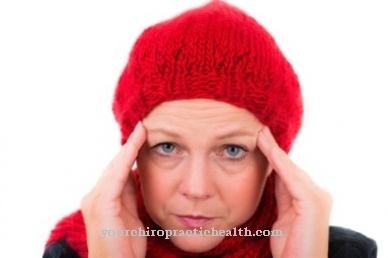Photosensitivity describes an increased sensitivity of the eye to the influence of light. As a result of the sensitivity, symptoms such as headache or eye pain arise.
What is photosensitivity?

Photosensitivity, also known as photophobia, is a collective medical term for increased sensitivity of the eyes that is triggered by the influence of natural or artificial light.
The light, the absorption of which the eyesight is bound to, is absorbed by nerve cells in the eye. Nerve cells convert the light impulses and pass them on to the brain. If the conversion and transfer process does not run smoothly, there will be impairments, including to photosensitivity.
Neurologically, sensitivity to light is synonymous with photosensitivity, the increased readiness of the brain to react to light. In particular, contrasts between light and dark, such as in television, video games or at the disco, trigger an increased willingness to react in the brain. When exposed to such light sources, epileptics can, in the worst case, have an epileptic seizure.
Dermatologically, one also sometimes speaks of a sensitivity to light. If the skin is sensitive to light, it will react abnormally to UVA and UVB light. Lesions form on the skin, similar to the symptoms of dermatitis. With some drugs there is a side effect of increased sensitivity to light.
causes
What exactly is the cause of the photosensitivity is not clearly understood. Presumably there are increased nerve impulses in the eyeball nerve. There is no clear reason for this; rather, sensitivity to light can have numerous different causes, including above all eye diseases or injuries and also neurological diseases.
Short-term sensitivity to light can be triggered by irritation due to foreign bodies in the eye or it can be the side effect of a cold.
Among the eye diseases, inflammation of the cornea (keratitis) is a common cause of photosensitivity, as the sensitive nerve endings in the cornea are extremely sensitive to inflammation. If the cornea is so irritated, even a small amount of light is enough to cause severe pain.
Another cause can be anterior uveitis, an inflammation of the iris. In addition to the iris, the ciliary bodies are also affected. Since sensors are located here that measure the light intensity and the amount of light incident is regulated via the pupillary reflex, inflammations lead to light sensitivity.
Other eye diseases that can lead to sensitivity to light include:
- Conjunctivitis
- Cataract
- glaucoma
Neurological diseases or the consequences of injuries are also possible criteria for photosensitivity. Illnesses associated with photosensitivity are:
- chronic sleep disorders
- migraine
- Shingles
- concussion
- Meningitis (inflammation of the meninges)
- and in rare cases, brain tumors
Other, albeit rare, reasons for photosensitivity can be:
- Albinism (therefore lack of pigmentation of the iris)
- total color blindness
- Bloom Syndrome
You can find your medication here
➔ Medicines against photosensitivity and irritated eyesDiseases with this symptom
- Conjunctivitis
- Cataract
- Brain tumor
- Albinism
- Meningism
- Vitamin deficiency
- glaucoma
- Uveitis
- Meningitis
- Color blindness
- Porphyria
- measles
- migraine
- Shingles
- concussion
- Bloom Syndrome
- Corneal inflammation
- Blood poisoning
Diagnosis & course
People who are sensitive to light usually intuitively avoid direct sunlight. Sore eyes and possibly headaches caused by exposure to light are indications of sensitivity to light.
Avoiding direct light irradiation, for example with sunglasses, leads to a lower light intensity and can provide short-term relief. However, if it is a more serious disease that is behind photosensitivity, this measure will not provide permanent relief. Consultation with an ophthalmologist can provide more detailed information on whether the eye is directly affected. If this is not the case, further specialists must be consulted.
Since photosensitivity does not usually appear as an isolated phenomenon, but as an accompanying symptom, the actual cause must be determined in order to treat it accordingly.
Complications
A sensitivity to light (photophobia) can be caused by external influences as well as diseases of the eye, which have various complications. Dilation of the pupils, which can occur with migraines or oculomotor paresis, also causes headaches due to the increased incidence of light, and vision is impaired.
For example, a sunburn can trigger photophobia, which heals in mild cases after one to two weeks without any complications. Some sunburns can leave scars. In addition, the skin ages much faster and the risk of developing skin cancer is drastically increased if sunburns occur frequently.
Inflammation of the cornea (keratitis) can also have serious complications. With appropriate treatment, this heals quickly. If left untreated, superinfection can develop as additional pathogens infect the eye. In the worst cases, it can cause scarring of the cornea, which can impair vision and lead to blindness.
A cataract can also lead to blindness if left untreated. An epileptic seizure can also lead to sensitivity to light. The most feared complication of epilepsy is status epilepticus, a long-lasting seizure that is associated with loss of consciousness. This emergency should be treated immediately because the mortality rate from congestion epilepticus cica is ten percent.
When should you go to the doctor?
Photosensitivity is only in some cases a problem that needs to be investigated by a doctor. It is relevant when the sensitivity to light occurs. Sensitivity to light in very bright daylight or in bright artificial light is normal. This reaction is a protective function of the human body in order to protect the sensory organs from damage. Therefore, there is no need to see a doctor if the symptom occurs in this context.
In some diseases, sensitivity to light occurs as a side effect. This is the case with migraines, for example. If the symptom disappears as the underlying disease subsides, a doctor's visit is not necessary. If the photosensitivity persists, an appointment should be made to be on the safe side. However, sensitivity to light can also be the result of serious illnesses that require treatment. Sensitivity to light in normal or even dark lighting conditions should be evaluated by a doctor. There may be damage to the eyes.
If there are other complaints in addition to photosensitivity, a doctor should also be consulted. These symptoms include headache, blurred or impaired vision, or excessive tension in the muscles of the face. If, in addition to sensitivity to light, you experience pain when you see or watery eyes, you should see an eye doctor immediately. In this case, damage to the eye cannot be ruled out and it should be treated promptly.
Doctors & therapists in your area
Treatment & Therapy
On the surface, sunglasses help with sensitivity to light. However, hiding symptoms is not a treatment. In order to really treat the photosensitivity, it is essential to find out the actual cause of the symptoms and treat them accordingly.
If the sensitivity to light is not due to lack of sleep or stress and disappears again after a short time, a possible disease or dysfunction of the eye must be clarified by an ophthalmologist. With appropriate drug treatment, there is a good chance of rapid relief.
In the case of neurological causes of photosensitivity, e.g. in the case of epilepsy, drugs help suppress sensitivity to light.
The side effects of strong photosensitivity, e.g. severe headaches can also be treated with pain relievers. If other medications are triggering the sensitivity, these can possibly be changed after consultation with the doctor.
Outlook & forecast
Eye diseases caused by light are summarized under the term light sensitivity. Those affected usually make do by wearing sunglasses. Whether artificial or natural light, the sick find it uncomfortable or painful.
Since photosensitivity can have many causes, the prognosis depends on the treatment option of the trigger. Often, corneal inflammation is the reason for photosensitivity. This can be treated with eye drops or medicated ointments. The cornea is riddled with many sensitive nerves that react particularly strongly to stimuli. Foreign bodies that injure the cornea can cause considerable discomfort. The sick person intuitively avoids bright light. Once the inflammation has subsided, normal tolerance is restored.
Migraines, organic diseases of the eye or the brain can also trigger sensitivity to light. The prognosis varies depending on the severity. Allergies such as hay fever also trigger an intolerance to light in many of those affected. The sun intensifies the allergic reaction, so that the patient suffers even more from watery eyes or sneezing fits.
Colds are also typical triggers for photosensitivity. Because the symptoms are aggravated by light, the patient avoids bright light sources. Once the cold has subsided or the migraine attack is over, sunlight no longer has any unpleasant consequences. Eye drops that moisturize the irritated eye are helpful.
You can find your medication here
➔ Medicines against photosensitivity and irritated eyesprevention
Since photosensitivity can have variable causes, there are various prophylactic measures. In general, light-sensitive people should wear sunglasses and avoid direct sunlight. Observing hygiene measures such as regular hand washing, especially before contact with the eye, protects against a large proportion of direct eye infections. For epileptics and people with neural sensitivity to light, harmful light sources, such as stroboscopic light, should be avoided.
You can do that yourself
In many cases, it is relatively difficult to determine why the photosensitivity occurs in a human. It can occur through psychological or chronic symptoms, which is why the methods for self-help are also relatively limited. In most cases, however, it is advisable to seek psychological advice. The causes of the photosensitivity can be clarified and the symptom treated.
Anyone who suffers from photosensitivity must protect their eyes from sunlight. This often creates complications in one's own life. The patient must wear sunglasses with UV protection and generally avoid stress and lack of sleep, as these symptoms only increase the sensitivity to light. Attention should always be paid to darkened rooms. If the photosensitivity is very strong or leads to severe pain, it is essential to consult a doctor. Self-help methods are relatively limited in terms of photosensitivity and can only worsen photosensitivity.
A healthy lifestyle often has a positive effect on the course of the disease. This definitely includes eating a healthy diet and taking up physical activity. However, it cannot be universally predicted whether this will limit the symptom.


.jpg)
























